一、概率分布于累积概率分布
%概率分布函数和累积概率分布函数
clear
x = 10*randn([10000,1]);
xi = linspace(-40,40,201);
subplot(311)
plot(x)%原始数据
grid on
xlabel('个数','FontSize',14);%设置X坐标标签
ylabel('值','FontSize',14);%设置Y坐标标签
subplot(312)
[y,X]=hist(x,100); %分为100个区间,统计每个区间个数)
y=y/length(x); %计算概率密度 ,频数除以数据种数,除以组距
bar(X,y,1); %用bar画图,最后的1是画bar图每条bar的宽度,默认是0.8所以不连续,改为1就可以了
grid on
xlim([-40 40]) %限定范围axis([xmin xmax ymin ymax])或者 ylim([ymin ymax])
xlabel('值','FontSize',14);%设置X坐标标签
ylabel('概率','FontSize',14);%设置Y坐标标签
%累计概率图
subplot(313)
F = ksdensity(x,xi,'function','cdf');
plot(xi,F);%累积概率函数图
grid on
xlabel('值','FontSize',14);%设置X坐标标签
ylabel('累积概率','FontSize',14);%设置Y坐标标签
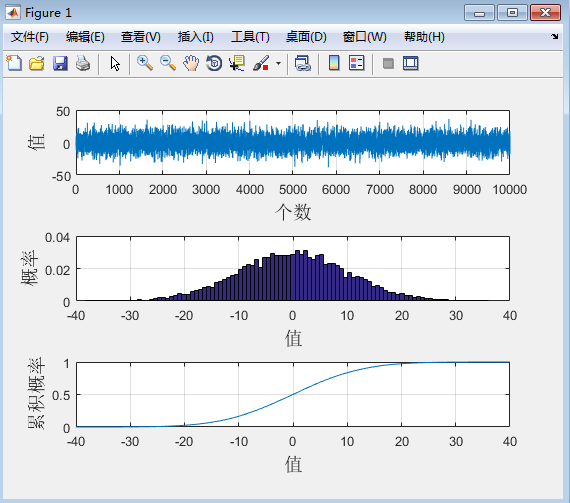
二、格式
clear all
h=0:0.1:100;
y1=h;
y2=2*h;
y3=3*h;
y4=4*h;
figure
subplot(221);
plot(h,y1)
title('y=x')
xlabel('X(m)')
ylabel('y(m)')
subplot(222);
plot(h,y2)
title('y=2*x')
xlabel('X(m)')
ylabel('y(m)')
subplot(223);
plot(h,y3)
title('y=3*x')
xlabel('X(m)')
ylabel('y(m)')
subplot(224);
plot(h,y4)
title('y=4*x')
xlabel('X(m)')
ylabel('y(m)')
suptitle('函数图')
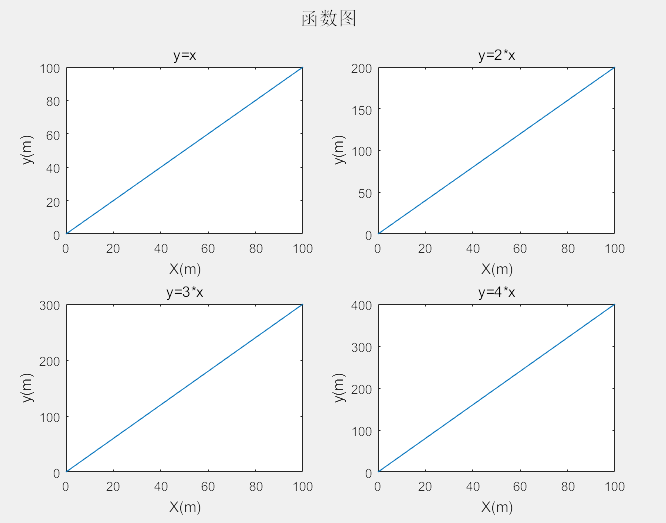
三、
两个colorbar 范围一致
clear all
k1=normrnd(10,10,50,50);
k2=normrnd(20,20,50,50);
subplot(1,2,2)
contourf(k2);
colormap(cool);
colorbar
k=caxis;
subplot(1,2,1);
contourf(k1)
caxis(k)
colorbar
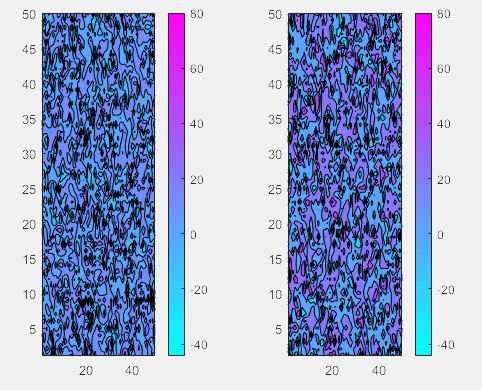
四、
clear all
subplot(221)
x = [5 10];
y = [3 6];
C = [0 2 4 6; 8 10 12 14; 16 18 20 22];
imagesc(x,y,C)
subplot(222)
h2=subplot(222)
get(h2, 'Position')%得到位置
set(h2,'Position',[0.5303 0.5838 0.3347 0.3412])%调整位置
x = [5 10];
y = [3 6];
C = [0 2 4 6; 8 10 12 14; 16 18 20 22];
imagesc(x,y,C)
subplot(223)
x = [5 10];
y = [3 6];
C = [0 2 4 6; 8 10 12 14; 16 18 20 22];
imagesc(x,y,C)
h4=subplot(224)
get(h4, 'Position')%得到位置
set(h4,'Position',[0.5303 0.1100 0.3347 0.3412])
x = [5 10];
y = [3 6];
C = [0 2 4 6; 8 10 12 14; 16 18 20 22];
imagesc(x,y,C)
hBar = colorbar;
get(hBar, 'Position') %这样可以得到colorbar的左下角x,y坐标,以及宽和高。
set(hBar, 'Position', [0.9 0.23 0.0324 0.5405])
caxis([5,15])%颜色条范围限制
hBar.Label.String ='路径损失(dB)';%颜色柱表示含义
set(hBar.Label,'fontsize',10);%字段大小
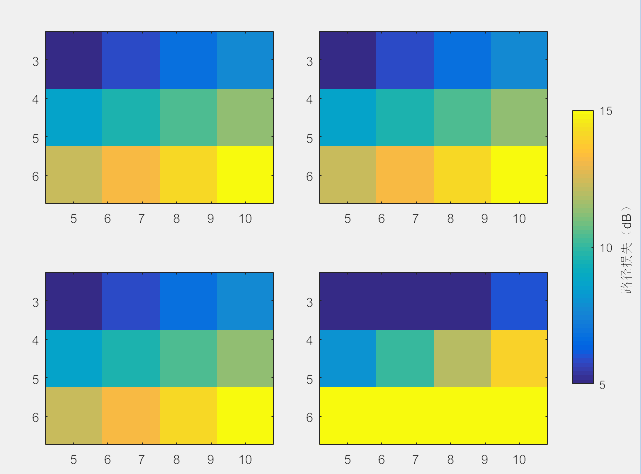
多个图合用一个颜色条,并且设置颜色条的位置,添加字体。
五、点图
clear all
x=[1:29];
y=ones(29);
figure
for i=1:15
plot(x,y*i,'.', 'MarkerSize',20,'Color','k');
hold on;
end
% axis([0 30 0 20]) %0坐标对不齐
% grid on
axis equal
ylim([0 16])
xlim([0 30])

六、圆
极坐标系
极坐标系(polar coordinates)是指在平面内由极点、极轴和极径组成的坐标系。在平面上取定一点O,称为极点。从O出发引一条射线Ox,称为极轴。
再取定一个单位长度,通常规定角度取逆时针方向为正。这样,平面上任一点P的位置就可以用线段OP的长度ρ以及从Ox到OP的角度θ来确定,
有序数对(ρ,θ)就称为P点的极坐标,记为P(ρ,θ);ρ称为P点的极径,θ称为P点的极角。
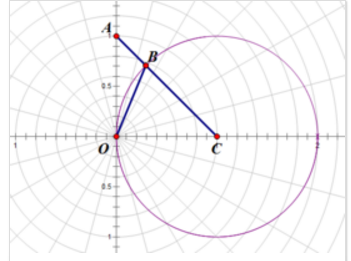
1、
figure
r=2;
theta=0:pi/180:2*pi;%360度
x=r*cos(theta);
y=r*sin(theta);
rho=r*sin(theta);
plot(x,y,'.','color','b')
%hold on;
axis equal
%fill(x,y,'c')
figure
h=polar(theta,rho);
set(h,'LineWidth',2)

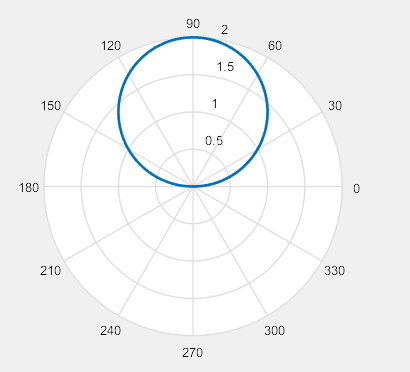
2、
clear all
figure
x=[1:29];
y=ones(29);
for i=1:15
plot(x,y*i,'.', 'MarkerSize',20,'Color','k');
hold on;
end
r=7;
theta=0:pi/180:2*pi;%360度,360个点。
x=15+r*cos(theta); %(15,7.5)圆心
y=7.5+r*sin(theta);
rho=r*sin(theta);
plot(x,y,'.','color','b')
axis equal
ylim([0 16])
xlim([0 30]) %范围限制





 本文介绍了使用Matlab进行数据可视化的方法,包括概率分布与累积概率分布的绘制、不同格式图表的展示、统一颜色条范围、调整子图位置及大小、绘制点图与圆形等实用技巧。
本文介绍了使用Matlab进行数据可视化的方法,包括概率分布与累积概率分布的绘制、不同格式图表的展示、统一颜色条范围、调整子图位置及大小、绘制点图与圆形等实用技巧。
















 3885
3885

 被折叠的 条评论
为什么被折叠?
被折叠的 条评论
为什么被折叠?








